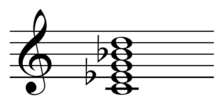Pentachord

A pentachord in music theory may be either of two things. In pitch-class set theory, a pentachord is defined as any five pitch classes, regarded as an unordered collection (Roeder 2001). In other contexts, a pentachord may be any consecutive five-note section of a diatonic scale (Latham 2002). A pentad is a five-note chord (Bailey 1991, 450).
Under the latter definition, a diatonic scale comprises five non-transpositionally equivalent pentachords rather than seven because the Ionian and Mixolydian pentachords and the Dorian and Aeolian pentachords are intervallically identical (CDEFG=GABCD; DEFGA=ABCDE).
The name "pentachord" was also given to a musical instrument, now in disuse, built to the specifications of Sir Edward Walpole. It was demonstrated by Karl Friedrich Abel at his first public concert in London, on 5 April 1759, when it was described as "newly invented" (Knape, Charters, and McVeigh 2001). In the dedication to Walpole of his cello sonatas op. 3, the cellist/composer James Cervetto praised the pentachord, declaring: "I know not a more fit Instrument to Accompany the Voice" (Charters 1973, 1224). Performances on the instrument are documented as late as 1783, after which it seems to have fallen out of use. It appears to have been similar to a five-string violoncello (McLamore 2004, 84).
References
- Bailey, Kathryn. 1991. The Twelve-note Music of Anton Webern: Old Forms in a New Language. Music in the Twentieth Century 2. Cambridge and New York: Cambridge University Press. ISBN 978-0-521-39088-0 (cloth). Reprinted Cambridge: Cambridge University Press, 2004. ISBN 978-0-521-54796-3 (pbk). Digital paperback reprint, Cambridge and New York: Cambridge University Press, 2006.
- Charters, Murray. 1973. "Abel in London". The Musical Times 114, no. 1570 (December): 1224–26.
- Knape, Walter, Murray R. Charters, and Simon McVeigh. 2001. "Abel: (4) Carl Friedrich Abel". The New Grove Dictionary of Music and Musicians, second edition, edited by Stanley Sadie and John Tyrrell. London: Macmillan Publishers.
- Latham, Alison (ed.). 2002. "Pentachord". The Oxford Companion to Music. Oxford and New York: Oxford University Press. ISBN 0-19-866212-2.
- McLamore, Alyson. 2004. "'By the Will and Order of Providence': The Wesley Family Concerts, 1779–1787". Royal Musical Association Research Chronicle, no. 37 (2004): 71–220.
- Roeder, John. 2001. "Set (ii)." The New Grove Dictionary of Music and Musicians, second edition, edited by Stanley Sadie and John Tyrrell. London: Macmillan Publishers.
Further reading
- Rahn, John. 1980. Basic Atonal Theory. Longman Music Series. New York and London: Longman Inc.. ISBN 0-582-28117-2.